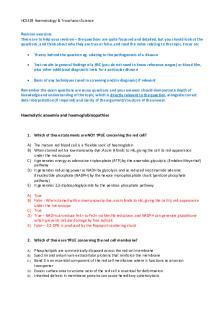Morphology Exercises with Key PDF

| Title | Morphology Exercises with Key |
|---|---|
| Author | Franziska Klaneiser |
| Course | Introduction to Linguistics I |
| Institution | Universität Graz |
| Pages | 3 |
| File Size | 155.5 KB |
| File Type | |
| Total Downloads | 78 |
| Total Views | 173 |
Summary
Morphology...
Description
ENH.01310UB Introduction to English linguistics I: Morphology and word formation exercises 1. The following words are made up of one or more morphemes. Isolate the morphemes and decide for each if it is free or bound, what kind of affix (if any) is involved (e.g. prefix, suffix…), and (where applicable) if the affix is inflectional or derivational. a. cats cat: free -s: bound inflectional suffix b. unhappy un-: bound derivational prefix happy: free c. Massachusetts free d. unspeakably un-: bound derivational prefix speak: free -able: bound derivational suffix -y: bound derivational suffix 2. In each group of words that follow, two words have the same morphological structure, one has a different suffix from those two, and one has no suffix at all. Your task is to tell which two words have the same suffix, which one has a different suffix, and which has no suffix at all. Having done this, tell the meaning of each suffix. Example: rider –er is a derivational suffix meaning “one who…” colder –er is an inflectional suffix marking the comparative silver there is no suffix smoker Same as for rider. a. clocks, Nick’s, hearts, glass clocks: bound inflectional suffix –s marking plural Nick’s: bound inflectional suffix –s marking possessive hearts: as for clocks glass: one free morpheme, no suffix b. nifty, ducky, thrifty, lucky nifty: one free morpheme, no suffix ducky: derivational suffix –y marking familiarity etc. thrifty: derivational suffix –y meaning “characterized by” lucky: as for thrifty 3. All of the words below contain two morphemes: a root and a suffix. First, identify the root in each word and the suffix. Then state the lexical category (e.g. noun, verb, adverb etc.) of the root word and the lexical category of the whole word. a. fictional root: fiction, suffix: -al (root is a noun and derived form an adjective) b. happiness root: happy, suffix: -ness (root is an adjective, derived form a noun) c. childish root: child, suffix: –ish (root is a noun, derived form an adjective) d. colorful root: color, suffix: -ful (root is a noun, derived form an adjective)
4. Draw tree diagrams for the following words: a. international
b. inconclusive
5. Examine the data below: (Luiseno)
a. Give the morpheme that corresponds to each English translation. Note that the plural marker has two allomorphs; list them both. i. son [kaamaj] ii. my [no] iii. blanket [taana] iv. their [pom] v. pipe [huukapi] b. Are the allomorphs of the plural marker phonologically conditioned? Yes c. If so, what are the conditioning environments? [um] after a consonant, [m] after a vowel 6. What is a morpheme? The smallest meaningful or grammatical part of a word. It cannot be broken down any further into even smaller meaningful units. (A word must have at least one morpheme, and a morpheme is not the same thing as a syllable! For example, even long words like Madagascar contain just one morpheme.) 7. For each of the following words of English, say what the root is and the process through which the word was formed: a. toenail toe and nail (compounding) b. mama ma (reduplication) c. café café (borrowing/loanword) d. discover cover (affixation) 8. Which of the following are compound words? a. carpet b. thousand c. heartbreaking d. swimming pool...
Similar Free PDFs

Morphology Exercises with Key
- 3 Pages

Chapter 9 Exercises - Answer Key
- 17 Pages

Key to all exercises - None
- 175 Pages

Extra Grammar Exercises Answer Key
- 13 Pages

Perfect Pizza with exercises 2
- 1 Pages
Popular Institutions
- Tinajero National High School - Annex
- Politeknik Caltex Riau
- Yokohama City University
- SGT University
- University of Al-Qadisiyah
- Divine Word College of Vigan
- Techniek College Rotterdam
- Universidade de Santiago
- Universiti Teknologi MARA Cawangan Johor Kampus Pasir Gudang
- Poltekkes Kemenkes Yogyakarta
- Baguio City National High School
- Colegio san marcos
- preparatoria uno
- Centro de Bachillerato Tecnológico Industrial y de Servicios No. 107
- Dalian Maritime University
- Quang Trung Secondary School
- Colegio Tecnológico en Informática
- Corporación Regional de Educación Superior
- Grupo CEDVA
- Dar Al Uloom University
- Centro de Estudios Preuniversitarios de la Universidad Nacional de Ingeniería
- 上智大学
- Aakash International School, Nuna Majara
- San Felipe Neri Catholic School
- Kang Chiao International School - New Taipei City
- Misamis Occidental National High School
- Institución Educativa Escuela Normal Juan Ladrilleros
- Kolehiyo ng Pantukan
- Batanes State College
- Instituto Continental
- Sekolah Menengah Kejuruan Kesehatan Kaltara (Tarakan)
- Colegio de La Inmaculada Concepcion - Cebu










